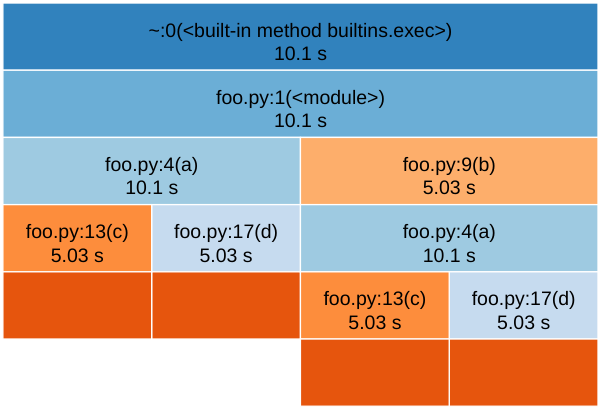
Performance analysis for Python.









tuna is a modern, lightweight Python profile viewer inspired by
SnakeViz. It handles runtime and import
profiles, has minimal dependencies, uses d3 and
bootstrap, and avoids
certain
errors present in SnakeViz (see
below) and is faster, too.
Create a runtime profile with
python -mcProfile -o program.prof yourfile.py
or an import
profile
with
python -X importtime yourfile.py 2> import.log
and show it with
tuna program.prof

Why tuna doesn't show the whole call tree
The whole timed call tree cannot be retrieved from profile data. Python developers
made the decision to only store parent data in profiles because it can be computed
with little overhead. To illustrate, consider the following program.
import time
def a(t0, t1):
c(t0)
d(t1)
def b():
a(1, 4)
def c(t):
time.sleep(t)
def d(t):
time.sleep(t)
if __name__ == "__main__":
a(4, 1)
b()
The root process (__main__) calls a() which spends 4 seconds in c() and 1 second
in d(). __main__ also calls b() which calls a(), this time spending 1 second in
c() and 4 seconds in d(). The profile, however, will only store that c() spent a
total of 5 seconds when called from a(), and likewise d(). The information that the
program spent more time in c() when called in root -> a() -> c() than when called in
root -> b() -> a() -> c() is not present in the profile.
tuna only displays the part of the timed call tree that can be deduced from the profile.
SnakeViz, on the other hand, tries to construct the entire call tree, but ends up
providing lots of wrong timings.
 |  |
|---|
| SnakeViz output. Wrong. | tuna output. Only shows what can be retrieved from the profile. |
Installation
tuna is available from the Python Package Index, so
simply do
pip install tuna
to install.
Testing
To run the tuna unit tests, check out this repository and type
pytest
IPython magics
tuna includes a tuna line / cell magic which can be used as a drop-in replacement for
the prun magic. Simply run %load_ext tuna to load the magic and then call it like
%tuna sleep(3) or
%%tuna
sleep(3)
prun is still used to do the actual profiling and then the results are displayed in
the notebook.
Development
After forking and cloning the repository, make sure to run make dep to install
additional dependencies (bootstrap and d3) which aren't stored in the repo.
License
This software is published under the GPLv3 license.














